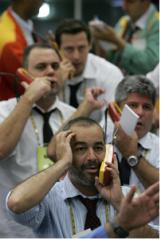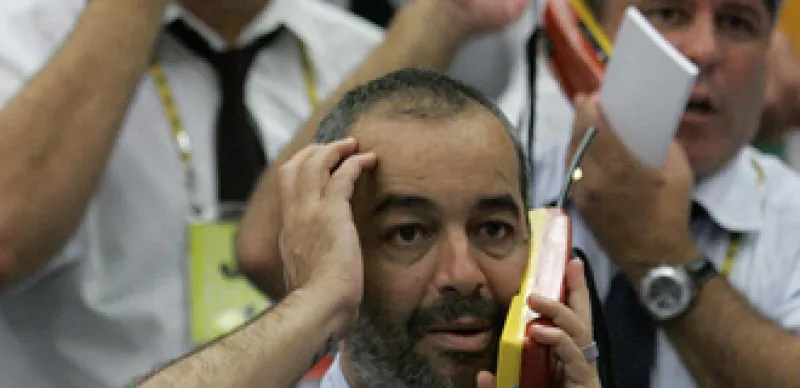Two years ago senior executives at Banco Itaú were looking for ways to attract foreign investors to the Brazilian market when they came up with an idea: Target Japanese investors with a campaign pegged to the centennial anniversary of mass Japanese immigration to Brazil, which started in 1908. So Itaú teamed up with Nikko Asset Management Co. to launch the Brazil Equity Fund in June 2008; one month later the bank paired with Daiwa Securities Group to introduce two more funds, the Brazil Fixed Income and Latam Equities funds. At about the same time, Banco Unibanco, a rival that Itaú acquired in February 2009, made its own splash in Japan by launching the Shinko Brazil Bond Fund, which was distributed by Shinko Securities Co.

“Japanese remember the positive economic impact that the Tokyo Olympics had in 1964 and believe it will have a similar effect in Brazil when the games take place in Rio de Janeiro in 2016,” says Roberto Nishikawa, director for institutional clients at Itaú Unibanco in São Paulo. “The funds’ success has surprised many people, including us.”
Japan isn’t the only country to have caught samba fever. Investors from around the world have been flocking to Brazil’s markets, looking to gain exposure to one of the largest and most-dynamic emerging-market economies. Domestic investors are exhibiting a similar bullishness, pouring more money into the country’s equity and bond markets. The result has been a boon for the country’s money managers.
Assets managed by the Brazil 20, Institutional Investor’s exclusive ranking of the country’s largest fund managers, increased by 43.7 percent in 2009, to the equivalent of $704 billion. BB Gestão de Recursos, the asset management arm of Banco do Brasil, extends its lead at the top of the table, growing its assets by 66.7 percent, to $175.3 billion. Itaú Unibanco comes in second, with $129.1 billion; that represents a 35.3 percent increase over the combined 2008 assets of Itaú and Unibanco.
Like many Brazilian managers, Itaú Unibanco has stepped up its efforts to attract foreign money, hoping to capitalize on the growing international appetite for emerging-markets assets. Overseas investors account for 15 percent of the firm’s assets under management. In April the manager set up a new subsidiary, Itaú Japan Asset Management, to target the Japanese institutional market. Other firms are pursuing similar strategies. That same month, SulAmérica Investimentos — the money management arm of Grupo SulAmérica, the Brazilian insurance giant 49 percent owned by the Netherlands’ ING Group — launched a Brazilian equities fund in Taiwan, which had raised $200 million by June. The company plans to launch a similar fund this summer that will be distributed by ING to institutions and high-net-worth individuals in 22 countries. It expects to raise $500 million in the short term.
“Brazil is in a very good economic position today compared with Europe and the U.S.,” says Marcelo Pimentel Mello, vice president of investments at SulAmérica in São Paulo. “It has stable inflation, a high level of central bank reserves and strong projected economic growth this year. There is huge global liquidity, and investors need to find new places to invest.”
As Brazil’s fund managers seek to extend their reach, foreign players are trying to increase their presence in the local market. Credit Suisse, which has been active in Brazil for a decade, advances one place in this year’s ranking, to No. 11, after increasing its assets by 59.4 percent last year, to $13.8 billion. The Swiss bank takes a two-pronged approach to the Brazilian market. Credit Suisse Hedging–Griffo Asset Management, which is majority owned by the Swiss bank, manages $10.7 billion for wealthy Brazilians, while the bank’s wholly owned Credit Suisse Asset Management runs $3.1 billion for institutional and retail investors.
“Emerging markets are becoming more and more important as an asset class, and within that universe, Brazil seems to be the one which has been attracting most of the attention from international investors,” says São Paulo–based Mauro Bergstein, managing director of CSAM in Brazil. “This creates a big opportunity for global players with strong local presence.”
Credit Suisse’s success hasn’t escaped the notice of other international players. Goldman Sachs Asset Management set up a local operation in Brazil in 2008 and launched three funds — a fixed-income fund, a hedge fund and a long-only equity fund — with seed capital to establish a track record. In October the firm opened those funds to Brazilian investors. It also launched three similar funds for distribution through Citigroup’s Brazilian network and introduced a multistrategy hedge fund aimed at Brazilian institutions.
In addition to those onshore funds, Goldman caters to foreign appetite for Brazilian assets through offshore emerging-markets equity, emerging-markets debt and BRIC funds. The company plans to launch an offshore fund dedicated to Brazilian equities later this year.
“Asia is waking up to Brazil,” says Gabriella Antici, chief investment officer and head of GSAM in Brazil. “A lot more capital from Asian investors will flow into the country within the next few years.” She expects similar interest from U.S. institutions. The top 200 American pension funds have only about 6 percent of their assets in emerging markets, well below those markets’ 13 percent weighting in the MSCI all-country world index, she notes.
In another sign of growing foreign interest in the Brazilian market, JPMorgan Chase & Co. is in talks to buy a stake in Gávea Investimentos, the No. 16–ranked, $5.8 billion hedge fund and private equity firm run by former Brazilian central bank governor Arminio Fraga.
The foreign interest in Brazil is easy to understand. The country’s asset management industry is one of the world’s fastest growing. According to the Investment Company Institute, the association of U.S. investment firms, Brazil’s fund management industry had assets of $784 billion at the end of 2009, making it the sixth-largest market in the world, just ahead of the U.K.’s $729 billion. (The U.S. has the largest fund industry, at $11.12 trillion.)
The Brazilian market represents 85 percent of the Latin American asset management industry, according to Banco Santander. With Brazil’s economy projected to expand by 5.5 percent this year, the outlook for continued growth is good.
There are more than 250 fund managers in Brazil, offering more than 8,200 funds, according to the Brazilian Financial and Capital Markets Association, or Anbima. Since 2000 the multimarkets sector — predominantly fixed-income funds that can invest in a range of asset classes — has increased in size 11-fold, and assets of the country’s pension funds have grown 14 times. Overall, the country’s funds industry has expanded by 150 percent during the past five years.
Brazil’s big banks have long dominated the fund management business, but changes in distribution are providing openings for foreign players and other new entrants. Clients are increasingly demanding some form of open architecture, and banks have responded by offering funds of funds, which invest in other managers’ products, and so-called white-label funds, which carry the bank’s brand but are managed by third parties.
“The big retail banks have started to move in the open-architecture direction,” says Goldman’s Antici. “That creates an opportunity for managers like us that are coming into the market. The banks want to be able to offer the best available products.”
Citigroup has an extensive retail presence in the Brazilian market, with 101 branches, but lacking its own asset management capability, it distributes products from Goldman Sachs and other fund managers. Santander Brasil Asset Management (No. 5, with $52.7 billion) already offers a fund of funds, which includes third-party products; and Bradesco Asset Management (No. 3, with $101.6 billion) is doing the same, mainly for its mass affluent clients.
The growing clout of institutional investors and private clients is also creating opportunities for newer players. Institutional investors made up 39 percent of the industry in March, up from 34 percent in October, according to Anbima. Private banking clients increased their share to 14 percent from 10 percent over the same period, while retail investors saw their share decline to 18 percent from 23 percent in October. The share of corporate investors remained the same, at 14 percent, while other types of investors dropped to 15 percent from 18 percent. (The percentages don’t total 100 because of rounding.) This shift is helping managers like BTG Pactual, the investment banking and asset management group controlled by billionaire banker André Esteves, which ranks seventh, with $29.2 billion in assets. The firm gets 40 percent of its assets from institutional investors and 23 percent from private banking clients. Corporate investors (24 percent) and international clients (12 percent) make up the rest.
The other big change in the market is the rapid growth of equity funds and alternative asset classes. Brazilian investors used to put most of their money into certificates of deposit or fixed-income funds because of the country’s high interest rates.
However, rates have come down sharply in recent years, in line with reduced inflation, giving investors an impetus to diversify their holdings. Between March and June the central bank raised its key short-term interest rate, the Selic rate, by 1.5 percentage points, to 10.25 percent, in a bid to contain inflation pressures, but that’s a far cry from the rates of 19 percent-plus that prevailed as recently as 2005.
“The Brazilian industry is a paradox in some ways,” says São Paulo-based Persio Arida, a former central bank governor and chairman of asset management at BTG Pactual. “Investors are very sophisticated, and the country has deep capital markets with many types of product available. However, the capital markets are very short-term orientated. Yet things are starting to change. Equities are becoming more important, and we have seen significant growth in the pension funds industry with the introduction of 401(k)-style pensions.”
“The biggest change to the Brazilian industry has been lower interest rates,” says Rodrigo Fiães, a partner at Gávea in Rio de Janeiro. “In the longer term rates are expected to continue falling, and that will strongly encourage institutional investors and pensions funds — which are very important to the overall industry — to invest in alternative investments.”
Eduardo Castro, head of fixed income at Santander Brasil Asset Management in São Paulo, says lower interest rates have spurred the growth of capital-protected funds: “They are quite sophisticated funds with fixed rates on the upside and capital protection on the downside.”
Some international firms are trying to tap into the market by providing more sophisticated products. AHL, the managed futures specialist owned by the U.K.’s Man Group, launched a fund in partnership with France’s Société Générale in December to offer managed futures to Brazilian onshore clients for the first time. So far it has raised 40 million reais ($22.5 million). SocGen manages the 80 percent of the fund that’s invested locally, and AHL runs the balance, which is invested in international markets, out of London.
Says Aurélio Ledergerber, Man’s Pfäffikon, Switzerland–based relationship manager, Americas, “We were attracted to Brazil because of the size of the market and the growth of private banking, family offices, and the increasing importance of institutional investors.”
He can expect plenty of company in the years ahead.






